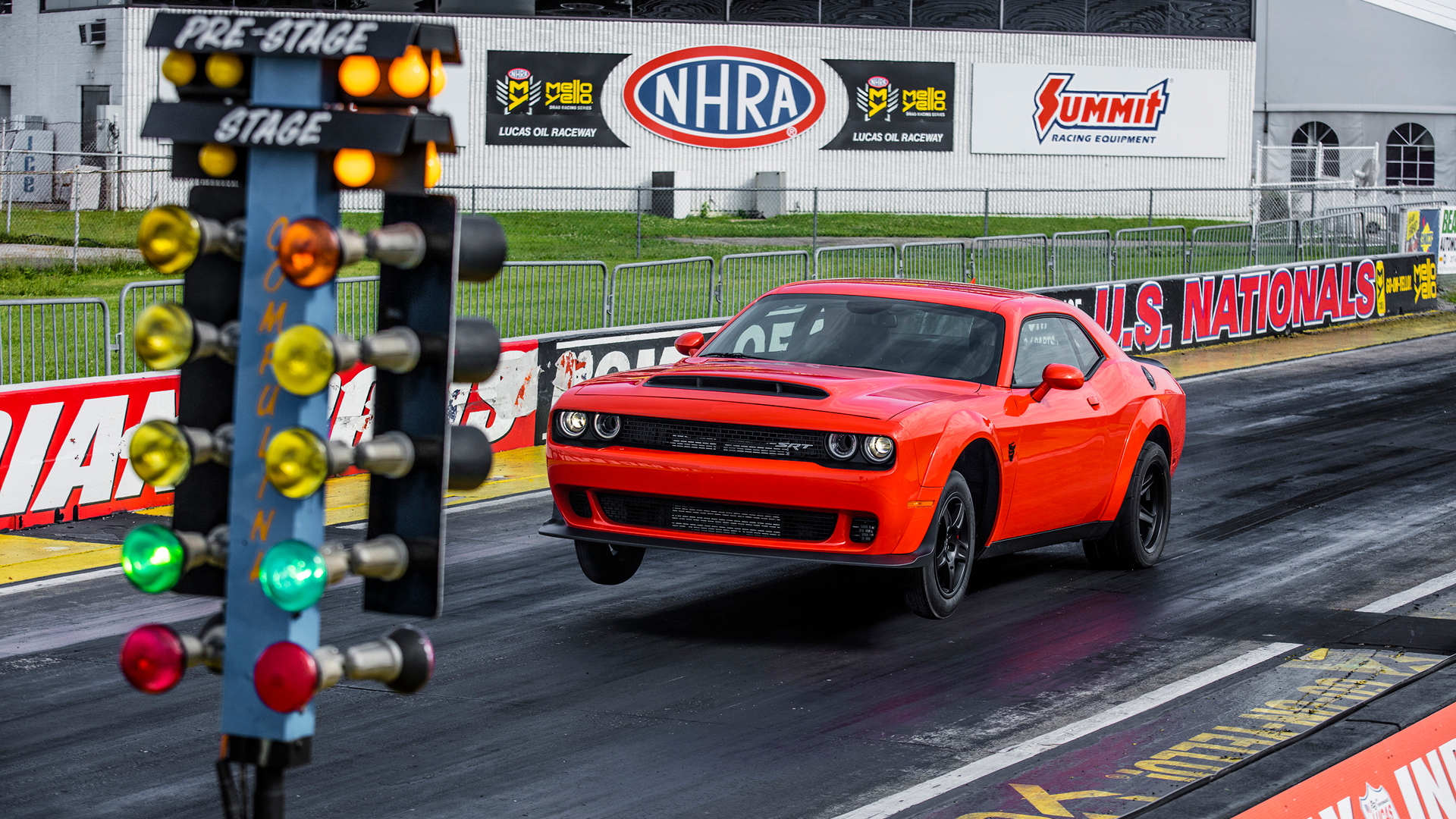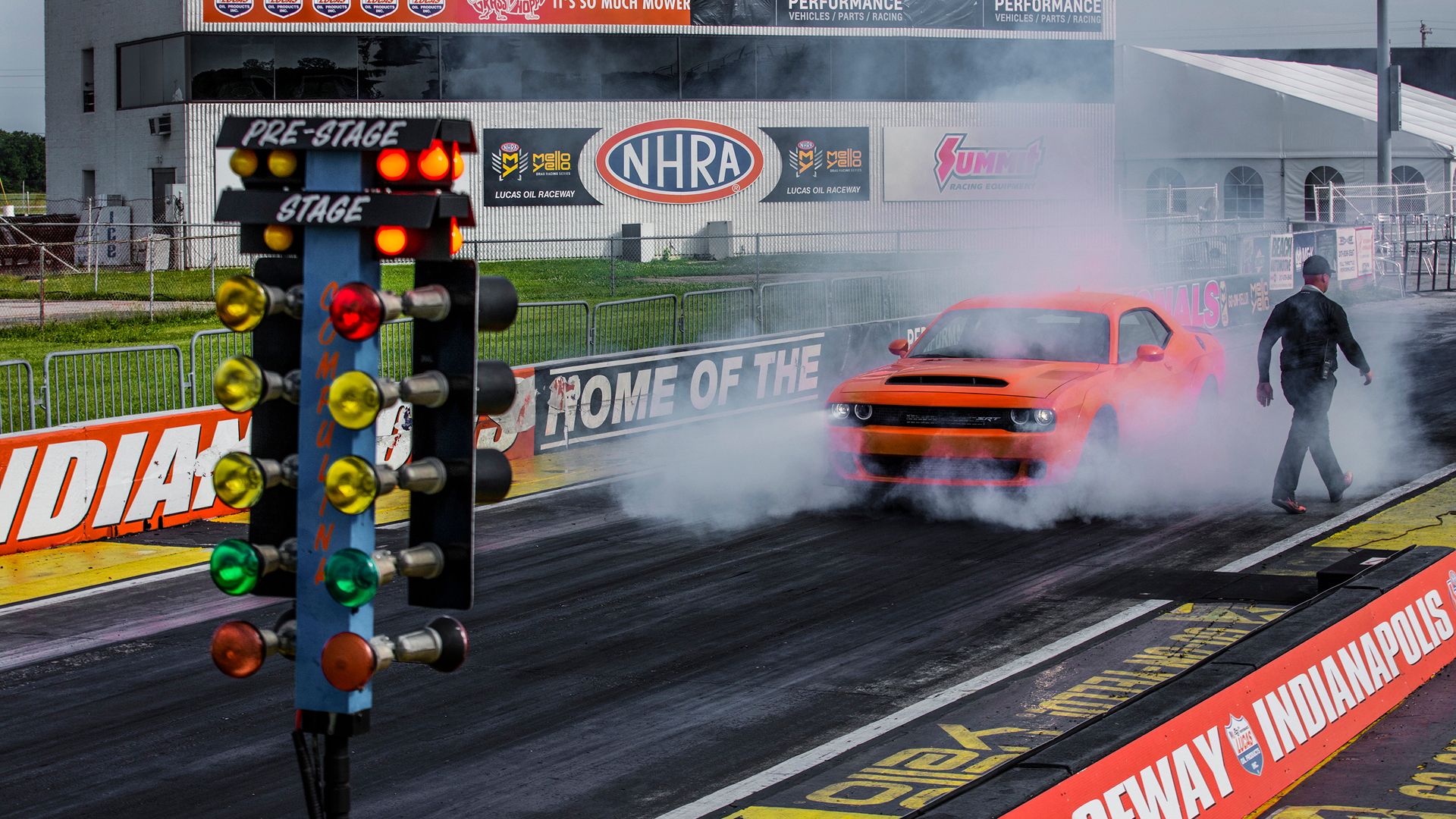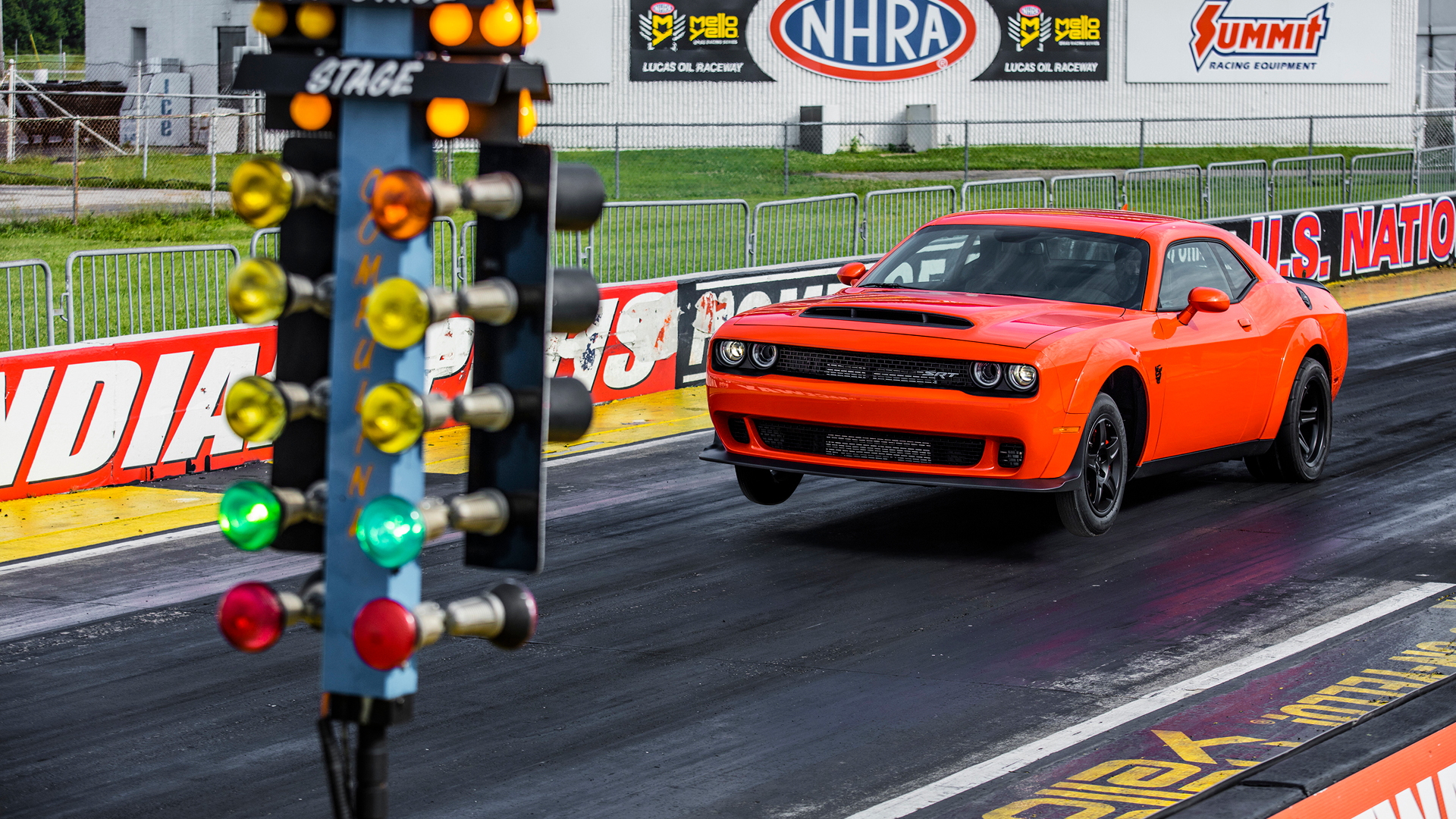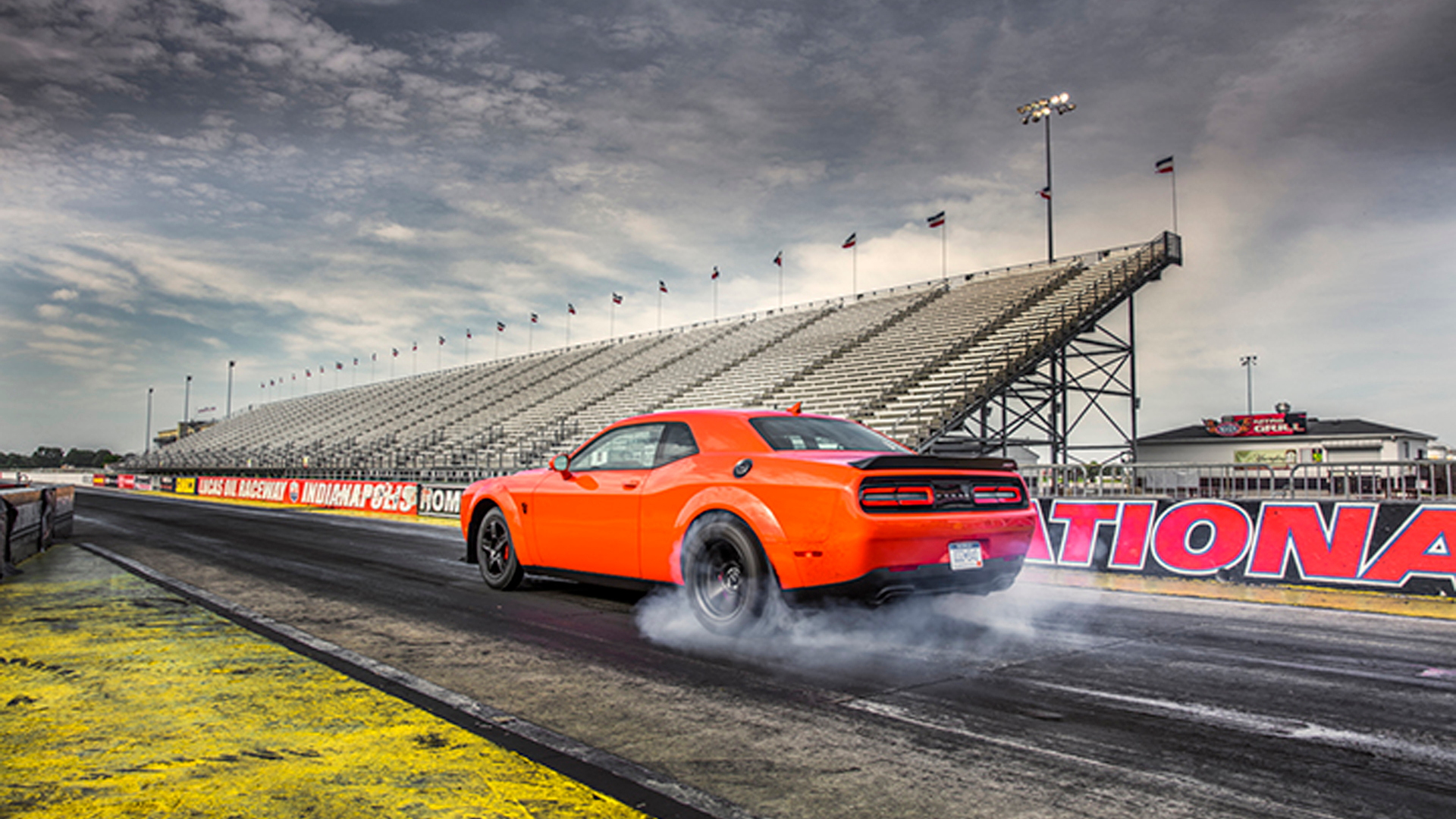Americans love excess, noise, and bombast, and the 2018 Dodge Challenger SRT Demon is as excessive, noisy, and bombastic as a car can get. But the ultimate Challenger is also a stunning piece of engineering, capable of nearly effortless straight-line performance unlike any car to ever carry a warranty.
That's good. And bad. But mostly good.
You didn't like your organs that way, right?
Pull back on both paddles with your left foot on the brake and build the revs—this is where some understanding of drag racing and a sticky, drag-prepped surface pays off. Try to ignore the odd sounds the Demon's engine is making at this point. It's perfectly normal for the car to sound like a pissed off attack helicopter before launch, when the Demon's Torque Reserve system is priming the powertrain for maximum performance.
MORE: The Demon's crate: What's in the box?
Release one of the paddles and wait for the Demon to ask you to release the brake pedal. How brave are we feeling today?
At that point, the TransBrake locks the Demon's output shaft, ensuring faster power delivery and even more torque at launch without overpowering the brakes. When curiosity and bravery intersect, release the last paddle and then feed in the gas in a quick and controlled manner.
The savage acceleration that follows is a little bit like BASE jumping. Drunk. And on fire. While riding a very perturbed cheetah. It's the most intense and visceral acceleration most people will ever experience.

2018 Dodge Challenger SRT Demon First Drive

2018 Dodge Challenger SRT Demon First Drive

2018 Dodge Challenger SRT Demon First Drive
Obsessive, excessive engineering
While the Demon's aesthetic might seem excessive, the changes are also functional. Its hood scoop is the largest on the market, force-feeding the huge 6.2-liter, supercharged V-8. The scoop works alongside a hidden intake in the middle of the driver's side, inboard headlight. The swollen wheel arches contain the enormous 315/45/18 tires, and the cleaver-like front splitter exists to beat the air into submission.
Are these changes excessive? Yeah, like a deep-fried, chocolate-covered stick of truffle-and-gold-flaked foie gras. But they're also necessary to cover the quarter mile in as little time as possible. But not as necessary as the engine.
The Demon is the definition of obsessive, excessive engineering, with the aforementioned 6.2-liter force-fed V-8 producing 840 horsepower and 770 pound-feet of torque. The Demon can hit 60 mph in 2.3 seconds, which feels like being kicked in the chest by a coked-out mule, and complete the quarter-mile dash in an NHRA-certified 9.65 seconds. There's an 8-speed automatic geared specifically for acceleration—consequently, the top speed drops to just 168 mph—and a dedicated Drag driving mode that optimizes all of the Demon's systems. The adaptive suspension has a special drag setting that sets up the dampers to improve off-the-line grip. And of course, there are specially built Nitto drag radials that are well over a foot wide.
But understanding these facts and features doesn't prepare you for the Demon's accessibility.
Takeoff
The headlining feature is TransBrake, a system that enables ferocious, brutal starts on a drag-prepped surface with a minimal amount of experience. Within two runs, I felt confident enough using TransBrake to kick out the engineer riding shotgun for the 1/8-mile passes, and move up to the big-boy 1/4 mile. With a range of effective prompts in the instrument cluster, the Demon walks its driver through getting the most potent launch possible.
Naturally, you can launch the Demon without using TransBrake, although I'm not really sure why you would—hell, the extra time it takes to engage the system might give the guy in the other lane a fighting chance…briefly. Dodge includes the Challenger's standard launch control system or you can also just plant your right foot, although neither method will work as well as TransBrake.
The hardest part of this entire affair is picking the right engine rpm and timing the throttle tip-in after releasing the second paddle. Go too early and the weight transfer is all screwy, meaning you won't have as much traction as the 6.2-liter, supercharged V-8 needs. Go too late, and the Demon bogs down with a palpable sense of annoyance at your incompetence. Ask me how I know.

2018 Dodge Challenger SRT Demon

2018 Dodge Challenger SRT Demon

2018 Dodge Challenger SRT Demon
Something is missing
Unfortunately, our figurative turns in the Demon were limited to the drag strip, so I can't comment on the ride, handling, or braking. That's a problem, and it's not the only one.
The Demon is a tremendously potent and hilariously fun vehicle, but it all feels too easy. When I was a young writer, I couldn't figure out how drag racers lit up their rear tires while stationary—it simply didn't compute. Now, all I need to do is climb in a Demon, press a button and follow the instructions to activate the built-in line lock system. Poof, tire smoke.
DON'T MISS: Dodge Demon can actually do 0-60 mph in 2.1 seconds, but there's a catch
It's the same story with TransBrake (and to a lesser extent the built-in launch control system). The Demon allowed me, someone with virtually no drag racing experience, to fire off a vehicle-indicated 10.6-second 1/4-mile run while pulling 1.6 G off the line. For better or worse, this is race-grade performance at driver's-ed-level accessibility.
To be clear, I'm not saying Dodge is irresponsible for putting the Demon on sale, or that it should specially license or train owners who buy one. If you're foolish enough to get behind the wheel of a Demon and mistreat it, you deserve whatever fate befalls you.
But I wish that getting the most out of this car was a little more challenging. Mastering a vehicle is a big part of what makes driving fun, but in the Demon's case, the joy comes merely from the sensory overload of the acceleration—and you'll adjust to that performance eventually, even at this level.
There's also a question of how long it takes to engage these systems. Some of our launches completely ignored the Christmas tree. While we staged the cars properly, TransBrake took too long to activate in time to hit the lights. Dodge said there were shortcuts owners will learn to activate the system—like a double-tap of the SRT button kicking the car into Drag mode—but it didn't elaborate on more of the Demon's secrets.
I also wish the Demon felt a little more special from behind the wheel.
While you can remove the front passenger and rear seats, you're still looking out on the same expansive Challenger dash, interacting with the same lickity-split UConnect infotainment system, steering with the same fat, leather-wrapped steering wheel, and reclining on the same wide but supportive seats. Unless the drag strip is stretching out ahead of you, it's difficult to get excited about sitting in the driver's seat. Dodge wouldn't need to go far to solve this problem—a unique driver's seat or a steering wheel could do the job.
These are minor problems, especially when the rest of the Demon is such a staggering performer (even in the hands of a novice). It's possibly the finest expression of a muscle car, ever. But we can't make that judgment for certain until we drive it on public roads, experience the foibles and idiosyncrasies of such a high-performance vehicle, and put Dodge's claim—that this stunning performer can drive to the track, switch to skinny runners, lay down a blistering, sub-10-second 1/4-mile time, and drive home again—to the test.
Until that happens, the Demon is the world's fastest curiosity, an ultra-high-performer with too many unknowns.
Dodge provided Internet Brands Automotive lodging to help bring you this firsthand report.





